Microsoft Office 2010 Mac System Requirements 5,0/5 5438 reviews
-->- System Requirements For Mq
- Microsoft Office 2010 Mac System Requirements For Malwarebytes
- Manjaro System Requirements
- Microsoft Office 2010 Mac System Requirements For Microsoft Office 2011
- Microsoft Office Mac
This article describes the software and device requirements for running Office Add-ins.
Note
If you plan to publish your add-in to AppSource and make it available within the Office experience, make sure that you conform to the Commercial marketplace certification policies. For example, to pass validation, your add-in must work across all platforms that support the methods that you define (for more information, see section 1120.3 and the Office Add-in host and availability page).
For a high-level view of where Office Add-ins are currently supported, see Office Add-in host and platform availability.
System Requirements For Mq
Office 2013 runs on 32-bit and 64-bit versions of Microsoft Windows operating systems. When you run Office 2013 32-bit on a 64-bit version of a Windows operating system, the program runs in the 32-bit layer of the Windows operating system. System requirements for Office. Mac: Office 2019 for Mac Home & Student includes Word, Excel, PowerPoint, and OneNote. And OneDrive mobile apps offer premium features to Office 365 subscribers. See the Microsoft Office Resources page for information about the extra features available with Office 365 on Windows Mobile, iOS, and Android. We would like to show you a description here but the site won’t allow us.
Server requirements
- ARCHIVED: For Mac OS X, what are the system requirements for Microsoft Office? This content has been archived, and is no longer maintained by Indiana University. Information here may no longer be accurate, and links may no longer be available or reliable.
- Before you install any Microsoft Office product, verify that your computer meets or exceeds the minimum system requirements for the product.
To be able to install and run any Office Add-in, you first need to deploy the manifest and webpage files for the UI and code of your add-in to the appropriate server locations.
For all types of add-ins (content, Outlook, and task pane add-ins and add-in commands), you need to deploy your add-in's webpage files to a web server, or web hosting service, such as Microsoft Azure.
While not strictly required in all add-in scenarios, using an HTTPS endpoint for your add-in is strongly recommended. Add-ins that are not SSL-secured (HTTPS) generate unsecure content warnings and errors during use. If you plan to run your add-in in Office on the web or publish your add-in to AppSource, it must be SSL-secured. If your add-in accesses external data and services, it should be SSL-secured to protect data in transit. Self-signed certificates can be used for development and testing, so long as the certificate is trusted on the local machine.
Tip
When you develop and debug an add-in in Visual Studio, Visual Studio deploys and runs your add-in's webpage files locally with IIS Express, and doesn't require an additional web server.
For content and task pane add-ins, in the supported Office host applications - Excel, PowerPoint, Project, or Word - you also need an app catalog on SharePoint to upload the add-in's XML manifest file.
Microsoft Office 2010 Mac System Requirements For Malwarebytes
To test and run an Outlook add-in, the user's Outlook email account must reside on Exchange 2013 or later, which is available through Office 365, Exchange Online, or through an on-premises installation. The user or administrator installs manifest files for Outlook add-ins on that server.
Note
POP and IMAP email accounts in Outlook don't support Office Add-ins.
Microsoft onenote mac chat help. Other regions will have this at a date to-be-determined. Commercial office 365 plans which include skype for businessand office online include: (except office 365 business).
Manjaro System Requirements
Client requirements: Windows desktop and tablet
The following software is required for developing an Office Add-in for the supported Office desktop clients or web clients that run on Windows-based desktop, laptop, or tablet devices:
For Windows x86 and x64 desktops, and tablets such as Surface Pro:
- The 32- or 64-bit version of Office 2013 or a later version, running on Windows 7 or a later version.
- Excel 2013, Outlook 2013, PowerPoint 2013, Project Professional 2013, Project 2013 SP1, Word 2013, or a later version of the Office client, if you are testing or running an Office Add-in specifically for one of these Office desktop clients. Office desktop clients can be installed on premises or via Click-to-Run on the client computer.
If you have a valid Office 365 subscription and you do not have access to the Office client, you can download and install the latest version of Office.
Internet Explorer 11 or Microsoft Edge (depending on the Windows and Office versions) must be installed but doesn't have to be the default browser. To support Office Add-ins, the Office client that acts as host uses browser components that are part of Internet Explorer 11 or Microsoft Edge. See Browsers used by Office Add-ins for more details.
Note
Internet Explorer's Enhanced Security Configuration (ESC) must be turned off for Office Web Add-ins to work. If you are using a Windows Server computer as your client when developing add-ins, note that ESC is turned on by default in Windows Server.
One of the following as the default browser: Internet Explorer 11, or the latest version of Microsoft Edge, Chrome, Firefox, or Safari (Mac OS).
In Outlook, the company has included a Propose New Time feature, the ability of seeing calendars side by side, and a weather forecast in the calendar view. For full review and paid version visit. And PowerPoint is pack with theme variants, which provide several color schemes for a theme. And the real-time co-authoring. Microsoft office 2019 download mac. In Excel, there is an addition of Recommended Charts feature, and Pivot Table Slicers.
An HTML and JavaScript editor such as Notepad, Visual Studio and the Microsoft Developer Tools, or a third-party web development tool.
Client requirements: OS X desktop
Outlook on Mac, which is distributed as part of Office 365, supports Outlook add-ins. Running Outlook add-ins in Outlook on Mac has the same requirements as Outlook on Mac itself: the operating system must be at least OS X v10.10 'Yosemite'. Because Outlook on Mac uses WebKit as a layout engine to render the add-in pages, there is no additional browser dependency.
The following are the minimum client versions of Office on Mac that support Office Add-ins.

- Word version 15.18 (160109)
- Excel version 15.19 (160206)
- PowerPoint version 15.24 (160614)

Client requirements: Browser support for Office web clients and SharePoint
Any browser that supports ECMAScript 5.1, HTML5, and CSS3, such as Internet Explorer 11, or the latest version of Microsoft Edge, Chrome, Firefox, or Safari (Mac OS).
Client requirements: non-Windows smartphone and tablet
Specifically for Outlook running in a browser on smartphones and non-Windows tablet devices, the following software is required for testing and running Outlook add-ins.
Microsoft Office 2010 Mac System Requirements For Microsoft Office 2011
| Host application | Device | Operating system | Exchange account | Mobile browser |
|---|---|---|---|---|
| Outlook on Android | Android tablets and smartphones | Android 4.4 KitKat later | On the latest update of Office 365 for business or Exchange Online | Native app for Android, browser not applicable |
| Outlook on iOS | iPad tablets, iPhone smartphones | iOS 11 or later | On the latest update of Office 365 for business or Exchange Online | Native app for iOS, browser not applicable |
| Outlook on the web | iPhone 4 or later, iPad 2 or later, iPod Touch 4 or later | iOS 5 or later | On Office 365, Exchange Online, or on premises on Exchange Server 2013 or later | Safari |
Microsoft Office Mac
Note
The native apps OWA for Android, OWA for iPad, and OWA for iPhone have been deprecated and are no longer required or available for testing Outlook add-ins.